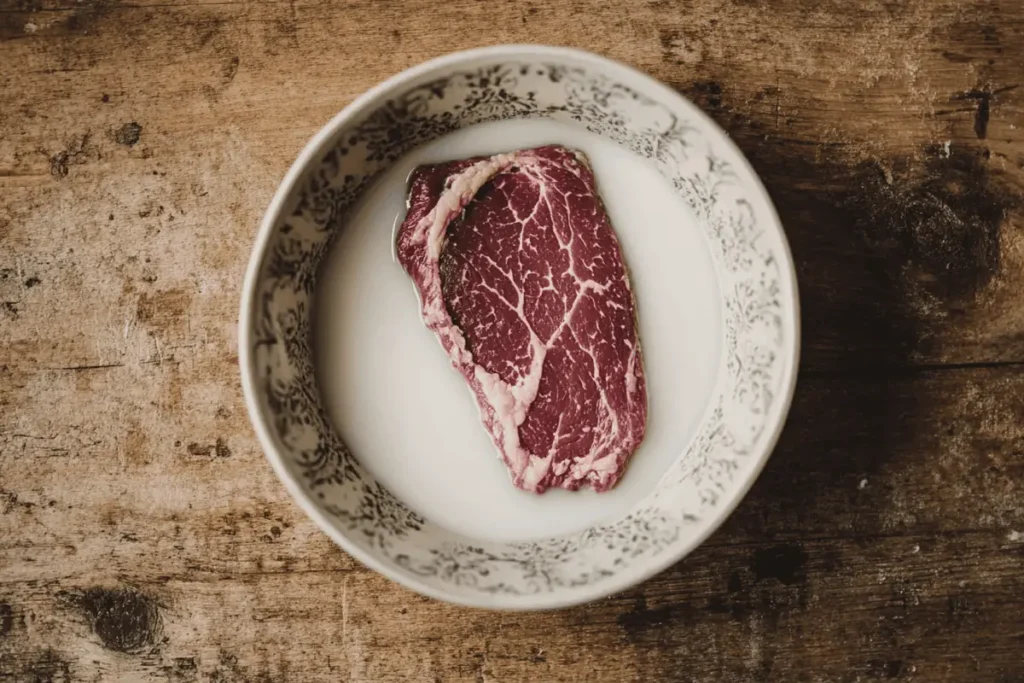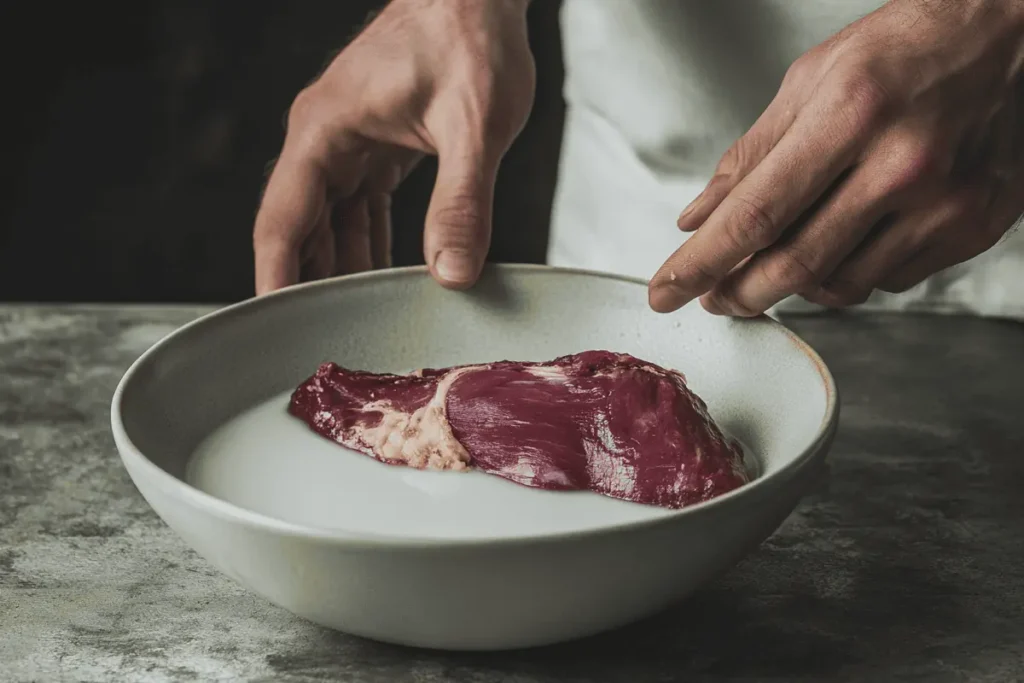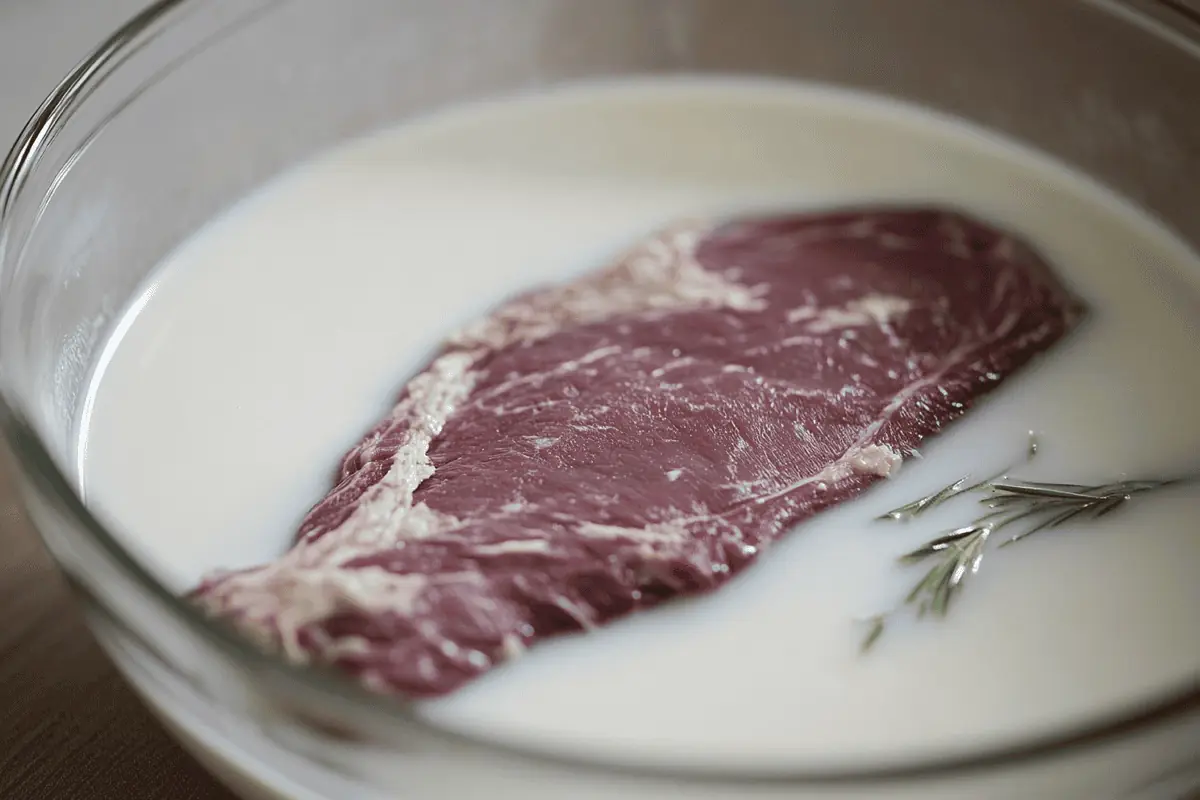Why do you soak deer backstrap in milk? Soaking deer backstrap in milk is a time-honored technique. This method tenderizes the meat. It also removes any gamey flavors, resulting in a more enjoyable meal, and the process is entirely natural. Therefore, understanding why people naturally soak deer backstrap in milk is essential for venison preparation.
Table of Contents
The Natural Benefits of Milk Soaking Deer Backstrap
Soaking deer backstrap naturally in milk is a common practice. It addresses several issues. The primary reason is to tenderize the meat. Furthermore, it helps to mellow the strong game flavor that venison can sometimes have. Wild game, unlike farm-raised meat, has a different flavor profile. Therefore, the natural process of soaking is essential. This process breaks down tough fibers. Consequently, the meat becomes more palatable. Understanding why to naturally soak deer backstrap in milk will improve your cooking. This is a key step in making delicious venison.
The Science Behind Naturally Tenderizing Venison in Milk
The science behind this method is straightforward. Milk contains lactic acid. This acid gently breaks down the proteins within the deer backstrap. Moreover, it does this without denaturing them completely. This process is entirely natural. Also, milk’s fats help bind with some of the compounds that cause the gamey taste. As a result, the overall flavor of the venison is significantly improved. This makes the meat both tender and more pleasant. Naturally soaking deer backstrap in milk leverages these chemical reactions. The process of using milk for venison is very beneficial.
How Milk Naturally Softens Deer Backstrap Tissue
The connective tissues within the venison can be quite tough. This is particularly true for older animals. Milk works naturally to soften these tissues. Therefore, it helps to create a more tender cut of meat. The longer you soak, the more pronounced the tenderizing effect will be. However, it’s important to note that excessive soaking may result in a mushy texture. Therefore, timing is crucial for best results. This method of preparing venison, naturally soaking deer backstrap in milk, ensures optimal tenderness. Thus, soaking venison is important for texture.
Why Naturally Soak Deer Backstrap to Remove Gamey Taste
Besides tenderization, removing the gamey taste is another important reason to soak the meat. Many hunters and home cooks seek a milder flavor. Milk naturally helps draw out some of the compounds that contribute to this gamey taste. For many, this enhances their enjoyment of venison. The result is a more savory eating experience. Knowing how to naturally soak deer backstrap in milk leads to better tasting results. This process is necessary for less gamey venison.
Understanding the Source of Venison’s Gamey Flavor
The gamey flavor in venison comes from several sources. For example, it can result from the animal’s diet. It can also come from the natural compounds within the muscle tissues. These compounds, such as certain fats, can create an undesirable taste. Naturally, milk’s properties help neutralize these flavor notes. This process leaves a cleaner taste. Therefore, understanding why to naturally soak deer backstrap in milk is important. It addresses issues that stem from wild venison.
The Natural Way Milk Neutralizes Gamey Flavors
The fat and proteins in milk bind with the volatile compounds in the venison. In doing so, they help to leach these flavors out of the meat. This process is entirely natural. Furthermore, the lactic acid also contributes to this flavor modulation. The end result is meat that is much more palatable for most people. Milk’s ability to mellow the gamey notes is, thus, crucial. Therefore, naturally soaking deer backstrap in milk makes venison more accessible. This is a major advantage of using milk when preparing venison.
The Best Way to Naturally Soak Deer Backstrap in Milk for Maximum Impact
The method for soaking venison is simple. However, some best practices can enhance the outcome. This ensures you get the most benefits from the process. For example, understanding how long to naturally soak deer backstrap in milk can greatly improve the final dish. This is crucial for properly preparing venison.
Choosing the Best Milk for Soaking Deer Backstrap
While whole milk is traditionally used, you can also use other types of milk. Options include 2%, skim milk, or even buttermilk. Buttermilk is particularly effective due to its high lactic acid content. Therefore, this helps tenderize and eliminate gamey flavors more efficiently. The choice of milk is dependent on your preference. Naturally, using any type will still benefit the venison. For example, some may choose almond or oat milk for dietary restrictions and the method is still viable. But the key is to naturally soak deer backstrap in milk. Thus, many options are available when soaking venison.
Step-by-Step Guide to Naturally Soaking Venison
- First, ensure your deer backstrap is properly cleaned.
- Then, place it in a glass or ceramic bowl. Avoid using a metal bowl.
- Next, pour enough milk over the meat to fully submerge it.
- Naturally, ensure the meat is completely covered.
- Cover the bowl with plastic wrap or an airtight lid.
- Finally, refrigerate the meat for the recommended time. Knowing the proper process for how to naturally soak deer backstrap in milk ensures success. Following the process is important when preparing venison.
How Long to Naturally Soak Deer Backstrap for Ideal Results
The soaking time can vary. Most recipes recommend between two to twelve hours. For more tenderizing and flavor removal, soak longer. A general rule is that a two-hour soak can improve the tenderness. And a 12-hour soak is useful for strong flavor. However, do not leave it for longer than 24 hours, or the texture may become too soft. Consider your preference for the final result. Moreover, the size of the cut also plays a role. Smaller pieces may tenderize faster. Knowing how long to naturally soak deer backstrap in milk depends on the specific cut. Therefore, time is key when soaking venison.

Naturally Enhancing Venison Dishes with Milk Soaking
Soaking deer backstrap naturally in milk can enhance many dishes. This simple step can make a significant difference in the final meal. You can enjoy more flavorful and tender venison. Consequently, it enhances the entire meal experience. Therefore, the benefits of naturally soaking deer backstrap in milk are undeniable. This technique makes all venison dishes taste better.
Preparing Venison After the Natural Milk Soak
After soaking, remove the deer backstrap from the milk. Rinse it under cold water. This helps wash away any residual milk. Pat the meat dry with paper towels. This prepares it for marinating or cooking. Naturally, patting it dry ensures proper searing. This also prevents excessive steaming during the cooking process. The preparation following the soak when you naturally soak deer backstrap in milk is crucial. This step is important when preparing venison.
Cooking Venison After the Natural Milk Soaking Process
Once soaked and dried, the venison is ready for various cooking methods. You can grill it, pan-sear it, or bake it. Additionally, the soaking process ensures the meat will be tender and flavorful. It will also cook more evenly. Whether you prefer a simple preparation or a gourmet dish, the result will be far more enjoyable. Therefore, it is a foundational preparation. Understanding that naturally soaking deer backstrap in milk is essential for optimal results. The result of properly soaked venison is undeniable.
Recipes That Showcase Naturally Soaked Deer Backstrap
Many recipes benefit from pre-soaked venison. Stews, roasts, and stir-fries are all great options. The mild, tenderized meat integrates seamlessly into complex flavors. These dishes also highlight the benefits of this method. It results in the natural taste of the meat without the gamey edge. The soaking process is therefore crucial. Furthermore, the improved texture makes for more elegant plating. The versatility of venison after you naturally soak deer backstrap in milk is impressive. These recipes allow for great tasting venison.
Other Natural Methods for Tenderizing Deer Backstrap
While milk is a common choice, other methods can also tenderize deer backstrap naturally. These options work similarly. They help to break down tough tissues. These options also present alternatives for various dietary needs. Knowing other alternatives to naturally soak deer backstrap in milk helps in different scenarios. This is beneficial for all types of venison.
Brining as a Natural Way to Tenderize Venison
Brining involves soaking the meat in a saltwater solution. This method helps to tenderize and season the meat at the same time. The salt also helps break down the proteins. This process yields a more moist and flavorful result. It’s another effective way to prepare venison. Furthermore, brining often adds additional flavor profiles. While it is different, brining achieves a similar effect as when you naturally soak deer backstrap in milk. Brining is another great method for tenderizing venison.
Using Marinades to Naturally Tenderize Deer Backstrap
Marinades are another method for tenderizing. The acidic components of a marinade help break down proteins. This process is similar to the action of milk’s lactic acid. Common ingredients include vinegar, citrus juices, and yogurt. Marinades also add flavor to the meat. It’s another viable method for naturally tenderizing venison. Indeed, marinades provide many options. Marinades offer a great alternative if you can not naturally soak deer backstrap in milk. They also offer unique ways to season venison.
Mechanical Tenderization: A Less Natural Approach for Venison
Mechanical tenderizing involves using tools to physically break down the muscle fibers. This can be achieved through pounding or using a meat tenderizer. It is a faster, less natural option compared to soaking. However, it can still be effective. Specifically, mechanical tenderizing helps to speed up the process. However, it doesn’t offer the same flavor enhancement as when you naturally soak deer backstrap in milk. Mechanical tenderization is not as beneficial to the taste of venison.
The Role of Enzymes in Naturally Tenderizing Meat
Beyond soaking in milk, other natural processes help tenderize meat. For instance, enzymes play a crucial role. They break down complex proteins into simpler ones. This process, known as proteolysis, makes meat more tender. Several fruits, like papaya and pineapple, contain enzymes that are great for tenderizing. Considering other methods beyond naturally soaking deer backstrap in milk adds variety. This adds to the understanding of tenderizing venison.
Leveraging Fruit Enzymes to Naturally Tenderize Deer Backstrap
Fruits like papaya contain an enzyme called papain. Similarly, pineapple contains bromelain. These enzymes help to break down the protein in meat. You can use a marinade with puréed fruit. Alternatively, add sliced fruits to the soaking liquid. The natural enzyme action will aid in tenderizing the meat. However, do not soak for extended periods as it may cause mushiness. The use of fruits offers another option to naturally soak deer backstrap in milk. It allows for unique flavor profiles when tenderizing venison.
The Natural Impact of Time on Tenderizing Venison
Time also plays a crucial role in tenderizing. Slow cooking at low temperatures can be a form of natural tenderization. Over time, the heat works to soften tough connective tissues. Methods such as braising or slow roasting can tenderize meat effectively. These methods can be used in conjunction with milk soaking. It creates a combination of techniques. The use of time adds another component when considering how to naturally soak deer backstrap in milk. Time is always a key factor when preparing venison.

Advanced Techniques for Naturally Preparing Deer Backstrap
For those looking to further enhance their venison cooking skills, combining techniques is a good approach. Combining these natural methods can result in superior results. Therefore, a thoughtful approach is recommended. Combining methods allows you to build on what you learn when you naturally soak deer backstrap in milk. These techniques expand on how to best prepare venison.
Combining Milk Soaking and Marinating for Venison
After soaking the venison in milk, you can follow with a marinade. This combines the benefits of both methods. The milk tenderizes, while the marinade adds flavor. This method, therefore, produces incredibly tender and flavorful meat. The two-step approach enhances the final outcome. This shows the benefit of using all the tools available to improve your skill in how to naturally soak deer backstrap in milk. Combining methods allows for incredibly tasty venison.
Dry Brining Venison After a Natural Milk Soak
Another method involves dry brining after soaking. Dry brining involves applying salt to the surface of the meat. The salt draws out moisture. Then, the moisture, along with the salt, is reabsorbed by the meat. This results in increased moisture retention during the cooking process. It also intensifies flavor. Combining these approaches will improve your venison. Dry brining offers yet another approach alongside naturally soaking deer backstrap in milk. These unique steps enhance venison even further.
The Importance of Resting Venison After Naturally Soaking
After cooking the venison, resting the meat is essential. This allows the juices to redistribute within the meat. Therefore, this results in a more tender and flavorful experience. Resting also allows for even slicing. Thus, resting is critical for optimal results. Consequently, it should always be considered after cooking. All methods for preparing venison work in conjunction with each other such as how you naturally soak deer backstrap in milk. Resting your venison is just as important as the preparation.
The Culinary Heritage of Soaking Venison Naturally
The practice of soaking venison is rooted in culinary history. It reflects a deep understanding of how to make game meat more palatable. This tradition has been passed down through generations. Indeed, it is a testament to the ingenuity of home cooks. This practice has allowed them to create delicious and satisfying meals from what was available to them naturally. The tradition, therefore, continues to this day. The heritage of how to naturally soak deer backstrap in milk is important. The tradition of preparing venison is important to consider.
Naturally Enhancing the Flavor of Venison Through Diet
The gamey flavor can sometimes be mitigated at its source. The deer’s diet plays a role in the taste of the meat. Deer that have eaten a more diverse and natural diet often have milder tasting meat. This is why the source of your venison is so important. It is another important factor in the final flavor. Therefore, understanding what the deer ate can make a difference. The source matters, along with knowing how to naturally soak deer backstrap in milk. Therefore, the source of your venison matters.
Key Takeaways: Why Soak Deer Backstrap Naturally in Milk?
In conclusion, soaking deer backstrap in milk offers several advantages. It tenderizes the meat by breaking down tough tissues. It also reduces gamey flavors. The result is a more palatable eating experience. This method is straightforward and effective. It helps you enjoy venison in a variety of dishes. Naturally, it’s a technique worth using. The practice remains a cornerstone of venison preparation. This method transforms tough cuts into delicious meals. Therefore, understanding why and how is vital. Especially when learning about how to naturally soak deer backstrap in milk. This process is fundamental when preparing venison.
Why This Technique Remains Popular for Preparing Venison
The method’s popularity stems from its simplicity. It is also effective. Home cooks and chefs alike value its ability to transform game meat. It enhances flavor and tenderness. This makes venison enjoyable for a wider audience. This is why, naturally, this technique has endured. It provides consistent and reliable results every time. The popularity of how to naturally soak deer backstrap in milk is well-earned. The preparation technique of soaking venison is very beneficial.
Tips for the Best Results When Naturally Soaking Deer Backstrap
For the best results, always choose fresh, high-quality venison. Also, follow the soaking instructions carefully. Pay attention to the timing. And lastly, don’t over-soak. This is key to achieving optimal tenderness and flavor. Naturally, proper technique leads to the most satisfying results. Therefore, proper preparation is always critical. This will give you the best outcome for your venison dishes. Moreover, consider all methods and apply those that best suit your preference. All these points are important to keep in mind when you naturally soak deer backstrap in milk. These best practices lead to the best venison dishes.
Frequently Asked Questions
What does soaking deer in milk do?
Soaking deer backstrap in milk tenderizes the meat. Also, it reduces the gamey flavor. The lactic acid in the milk breaks down proteins. This makes the meat more palatable. Furthermore, it helps neutralize any undesirable flavors. This, therefore, enhances the overall eating experience. It is all about making venison more enjoyable when you naturally soak deer backstrap in milk.
Do you rinse meat after soaking in milk?
Yes, you should rinse the meat after soaking in milk. This helps to remove any residual milk. You should then pat the meat dry with paper towels. This also prepares the meat for the next cooking step. This ensures a good sear and even cooking. The step after you naturally soak deer backstrap in milk is important. This helps prevent any unwanted flavors from the milk.
Should you soak a deer backstrap before cooking?
Yes, it is highly recommended to soak a deer backstrap before cooking. This process helps tenderize the meat. It also mellows the gamey flavor of venison. This results in a more pleasant dish. It’s a beneficial step to take before cooking venison. Specifically, it helps make the venison enjoyable for even those with strong preferences. Therefore, understanding how to naturally soak deer backstrap in milk is crucial. This will greatly improve the flavor of the venison.
What are the benefits of soaking meat in milk?
The benefits of soaking meat in milk include tenderizing the meat. Additionally, soaking helps to mellow the gamey taste. It also enhances the overall flavor of the meat. This process makes it more enjoyable for many. Ultimately, the result is more tender and palatable meat. Therefore, it is a valuable preparation technique for venison. It is essential for anyone who wants to know how to naturally soak deer backstrap in milk. The result is much better tasting venison.

